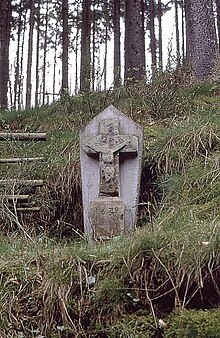Crossroads in Lösnich
Some of the road and field crosses in the Moselle village of Lösnich in the Bernkastel-Wittlich district are among the cultural monuments in Rhineland-Palatinate . They go back to the 17th century.
history
Crosses made of red sandstone can be found again and again in the Moselle region. They were set up on special occasions and thus represented thanks to God for overcoming wars or epidemics, or they were donated and erected because of salvation from a special emergency or to avert weather disasters.
During the French occupation (1794–1814 ), many crosses were destroyed in this area, as they were banned here in the course of secularization.
The fragments of a sandstone cross lying around in the Lösnich parish garden could still be a witness of this activity.
Crossroads at the former elementary school
Several of these crosses have survived in Lösnich itself. At the entrance to the former Lösnich school , to the right of the entrance to the apartment, on the outer wall, is the cross from 1659, which was repainted in 2011. The inscription in capital letters is still legible and reads: “This cross in honor of God's Ufricht let Joh. Math. Baur and Barbara Leutz v. Earth". Above the inscription is the house brand of the builder Johann Matthias Baur, a wolf tang with several commas.
Crossroads in the center of the village
Another crucifixion shrine is located in the center of the village at house no. 50, marked with the year 1721. The inscription reads: “Dises Creutz steet af Erden that God should be praised and praised.” In its neat decoration, it shows under the crucified, surrounded by seven swords, the painful mother Mary with the body of Christ. Below is a picture of the church patron St. Vitus in a kettle boiling oil. Nothing further is known about the founder.
Crossroads on the other side of the Moselle
Outside the village on the opposite side of the Moselle there is a crossroads on the edge of the vineyards . The construction is dated to 1701. The inscription reads: “Dis Creutz promised in honor of God before his death Thomas Jacob Iungesel from Lohsenich and was erected in 1701.” The Mother of God is depicted below the crucified Christ with the body of Christ. Before the construction of the Moselle bridge Erden-Lösnich, the cross was in the old ferry house on the Fährkopf . After the ferry service was discontinued and the ferry house was later demolished due to the raising of federal highway 53 as part of the land consolidation process , the cross was moved to its current location. In 2001 the cross was restored and now damaged and partly stolen figures were replaced.
Mission cross in the cemetery
A simple sandstone cross with a purgatory motif and the engraved dedication "CRUX MISIONIS" stands at the exit of the Lösnich churchyard on the mountain side. The construction date is not known. To renew the faith of the Christian population, the church increasingly used the means of popular or community missions in the mid-19th century . Specially trained priests and religious gave special sermons and religious talks on site. The cross was probably erected in memory of one of these missions.
Floor cross at the "robber bell"
This simple, small cross made of red sandstone stands in the forest area near the footpath to the Hubertus spring and bears the year 1638. Its date of creation falls during the Thirty Years War (1618–1648). Nothing further is known about the reason for its construction. It could be reminiscent of an accident or a so-called plague cross . Plague cases in the Moselle area were also reported at the time of installation.
Field cross in the castle bush
This simple black cross without a dedication in the middle of the forest in the Burgbüsch corridor was still there in the early 1980s. In 2014 it was no longer found. Nothing further is known about the display and the motif.
Crossroads in the parish garden
In 1981, in the garden of the old rectory on Fährstrasse, there were still remains of an already destroyed sandstone cross. According to the inscription, the cross was erected in 1727 by the heirs of Nikolaus Schmitges.











